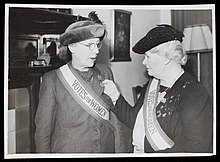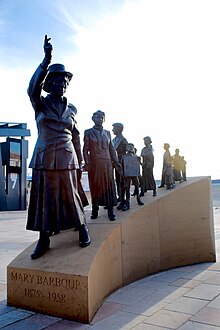Helen Crawfurd
Helen Crawfurd | |
|---|---|
 | |
| Born | Helen Jack 9 November 1877 Glasgow,Scotland |
| Died | 18 April 1954(aged 76) Dunoon,Scotland |
| Nationality | Scottish |
| Occupation(s) | Politician, activist, suffragette |
| Notable work | Suffragette, activist, politician |
| Spouses |
|
Helen Crawfurd(néeJack,laterAnderson;9 November 1877 – 18 April 1954) was a Scottishsuffragette,rent strikeorganiser, Communist activist and politician. Born inGlasgow,she was brought up there and in London.
Biography
[edit]BornHelen Jackat 175 Cumberland Street in theGorbalsarea of Glasgow, her parents were Helen L. (néeKyle) and William Jack.[1]Her mother worked a steam-loom before she wed.[2]Helen's family moved toIpswichwhile she was young. Crawfurd later went to school in London and Ipswich before moving back to Glasgow as a teenager. Crawfurd's father, a master baker,[1]was aCatholic,but converted to theChurch of Scotlandand became a conservativetrade unionist.

Initially religious herself and a Sunday School teacher, Crawfurd felt a call to be married at 21 to the 67-year-old widower Alexander Montgomerie Crawfurd (29 August 1828 – 31 May 1914), a Church of Scotland minister and family friend.[2][3][4][5]However, she became increasingly radical, after witnessing injustices, and what she deemed to be "un-Christian" behaviour from the Church.[6]For example, not helping widows financially before they had sold all their belongings in their home.[7]Alexander died, aged 85, at 17 Sutherland Street in Partick, Glasgow.
In 1944, Crawfurd remarried, to widower George Anderson of Anderson Brothers Engineers,Coatbridge.Her second husband was a member of theCommunist Party of Great Britain.[8]George Anderson died on 2 February 1952 and Crawfurd two years later at Mahson Cottage, Kilbride Avenue, Dunoon, Argyll, aged 76.[9][10]
Political activity
[edit]Crawfurd first became active in thewomen's suffragemovement in about 1900, then in 1910 at a meeting inRutherglen.[11]Crawfurd was jailed three times for "militant" political activity during her career as an activist.[12]In 1912, Crawfurd smashed the windows ofJack Pease,Minister for Education, and received a one-month prison sentence. In March 1914, Crawfurd was arrested in Glasgow whenEmmeline Pankhurstwas speaking. She received another month in prison[2]and went on an eight-dayhunger strike.[11]She spoke at the Music Hall, Aberdeen on 26 February 1914, in favour of militarism.[13]But after one further arrest, Crawfurd left the WSPU in protest at its support ofthe First World Warand in 1914 she joined theIndependent Labour Party(ILP).[2][6]

During WWI, Crawfurd was involved with theRed Clydesidemovement, including theGlasgow rent strikesin 1915 when she led theSouth Govan Women's Housing Associationto resist rent increases and prevent evictions, alongsideMary Barbour,Mary Laird,Mary Jeff,Jessie StephensandAgnes Dollan.Crawfurd had co-founded the Glasgow branch of theWomen's International League[2]and become secretary ofthe Women's Peace Crusade.[14]By then she had metAgnes Harbenand others, who held the same international perspectives.[15]On 23 July 1916, Crawfurd organised the first demonstration of the Women's Peace Crusade, which was attended by 5,000.[16][17]Crawfurd formed a branch of theUnited Suffragistsin Glasgow.[18]These women used the realms of domesticity entrenched within society to support their campaign, known as "Wives and Weans Socialism".[19]
A Propagandist’s Work Is Never Done.
[edit]The Women’s Peace Crusade (WPC) was the first popular campaign that linked Feminism with Antimilitarism. The realm of maternalism was exploited by Agnes Dollan and Crawfurd and their involvement with the WPC. They encouraged women to be anti-war on the basis that they were the creators of life and, consequently, in neglecting to protect their sons’ lives they were neglecting their maternal roles.[20]Crawfurd and Dollan were grassroots propagandists. Both women travelled the length and breadth of Scotland to inform the public that fighting in the war was not the exciting adventure their sons, husbands and fathers had been sold; they were, as Dollan describes, being ‘consumed as common fodder.’[21]The emotional nature of their speeches convinced women to become members of the WPC and, in turn, learn about the wider Clydeside movement. Open-air and public hall meetings frequented almost every town and village and they drew in large audiences; up to 5000 women demonstrated inGlasgow Greenfor anti-war and anti-conscription rallies.[22]Crawfurd stated at a public meeting that ‘Christ came that we might have life more abundantly’ in her appeal for the cessation of the brutal war.[23]Gallacher recalls the demonstrations established by the WPC, stating ‘they showed the men how a demonstration should be organised.'[24]He describe the scenes at Glasgow Green to protest the war. The women used banners, streamers, orators, and marches throughout Glasgow to ensure their plight was heard.[24]Klaskoalso recalls her attendance at the WPC demonstrations, she states that she was anti-war and anti-conscription and participated in the discussions at a young age. She remembers candidly some older demonstrators quieting the crowd to ‘let the wee lassie speak.’[25]It is recollections such as these that truly highlight the collective effervescence of the movement.
The End of WWI
[edit]In 1918, Crawfurd was elected as vice-chair of the Scottish division of theIndependent Labour Party(ILP), and was said to be a convincing speaker when she spoke in the Market Place at the branch meeting inLoftus.[26]Shortly afterwards, Crawfurd became a founder member of the ILP's left-wing faction, which was campaigning for it to affiliate to theCommunist International.Crawford went to Moscow in 1920, withMarjory Newbold,Sylvia Pankhurst,Willie Gallacherand others for the Congress of the Third Communist International and interviewedLenin.[27][2]When the affiliation policy was defeated, Crawfurd joined the newCommunist Party of Great Britain(CPGB). She served on its Central Committee and involved herself in various journalistic projects. She also became secretary ofWorkers' International Relief.[6]

In 1919, Crawfurd was a delegate to the Congress of theWomen's International LeagueinZürich.[28]
Crawfurd ran in 1921 as the first Communist Party candidate in theGovanward of Glasgow.[29]
In 1927, Crawfurd was an official delegate to the Brussels International Conference against Oppressed Nationalities,[30]at which theLeague against Imperialismwas established. Crawfurd joined the executive of the British section.[31]
Crawfurd stood for the CPGB inBothwellat the1929 general election,andAberdeen Northin1931,but did not come close to being elected.[6]
During the 1930s, Crawfurd was prominent in the Friends of the Soviet Union. She unsuccessfully stood forDunoonTown Council in 1938.[32]However, she was elected as Dunoon's first woman town councillor shortly after the war,[11]but retired from it in 1947 due to poor health.[6][33] Helen Crawfurd (by then Mrs Anderson) died in 1954 at Mahson Cottage, Kilbride Avenue, Dunoon, Argyll, aged 76.[2][10]
Further reading
[edit]- Wilkins, K. (2023). Helen Crawfurd (1877–1954): Scottish Suffragette and International Communist. In: de Haan, F. (eds) The Palgrave Handbook of Communist Women Activists around the World. Palgrave Macmillan, Cham.https://doi.org/10.1007/978-3-031-13127-1_5
References
[edit]- ^ab"SR Birth Search for Helen Jack (Statutory Births 644/12 1466)".Scotland's People.
- ^abcdefgAtkinson, Diane (2018).Rise up, women! the remarkable lives of the suffragettes.London: Bloomsbury. pp. 308, 532.ISBN9781408844045.OCLC1016848621.
- ^"OR Birth and Baptism Search CRAWFORD, ALEXANDER (O.P.R. Births 612/01 0020 0089 ST QUIVOX)".Scotland's People.
- ^"SR Death Search for Alexander Montgomerie Crawfurd (Statutory Deaths 644/22 0321)".Scotland's People.
- ^"SR Marriage Search for CRAWFORD, ALEXANDER M - JACK, HELEN (Statutory Marriages 490/00 0075)".Scotland's People.
- ^abcdeA. T. Lane, ed.,Biographical Dictionary of European Labor Leaders, Vol. 1,pp. 224–226.
- ^"Helen Crawfurd by MARX MEMORIAL LIBRARY & WORKERS' SCHOOL - Issuu".issuu.com.28 January 2016.Retrieved9 May2023.
- ^"SR Marriage Search Anderson George Crawford Helen COATBRIDGE OR OLD MONKLAND Lanark 652/02 0071".Scotland's People.
- ^"SR Death Search ANDERSON, GEORGE (Statutory Deaths 510/02 0002)".Scotland's People.
- ^ab"SR Death Search ANDERSON, HELEN (Statutory Deaths 510/01 0067)".Scotland's People.
- ^abcLeneman, Leah (2000).The Scottish Suffragettes.British Library: NMS Publishing Limited. pp. 58–61.ISBN1-901663-40-X.
- ^Castells, Manuel, 1942- (1983).The city and the grassroots: a cross-cultural theory of urban social movements.Berkeley: University of California Press.ISBN0-520-04756-7.OCLC8929555.
{{cite book}}:CS1 maint: multiple names: authors list (link) CS1 maint: numeric names: authors list (link) - ^Pedersen, Sarah."The Aberdeen Women's Suffrage Campaign".suffrageaberdeen.co.uk.copyright WildFireOne.Retrieved18 March2023.
- ^"The Peace Negitiations Memorial".Forward.8 July 1916.
- ^"Women's International League".Spartacus Educational.Retrieved21 January2021.
- ^Liddington, Jill (1984).The Life and Times of a Respectable Rebel: Selina Cooper (1864–1946).Virago.
- ^Wiltshire, Anna (1985).Most Dangerous Women: Feminist Peace Campaigners of the Great War.Pandora.
- ^"Suffrage in Glasgow".Votes for Women.30 July 1915.
- ^Hughes, Annmarie (2010).Gender and Political Identities in Scotland, 1919-1939.Edinburgh Scholarship Publishing.
- ^"Dr Lesley Orr speaks about Suffragette and Rent Striker Helen Crawfurd | Protests & Suffragettes was live. | By Protests & Suffragettes | Facebook".www.facebook.com.Retrieved9 May2023.
- ^Corr, Helen (23 September 2004)."Dollan [née Moir], Agnes Johnston, Lady Dollan (1887–1966), suffragette and socialist".Oxford Dictionary of National Biography.Oxford Dictionary of National Biography (online ed.). Oxford University Press.doi:10.1093/ref:odnb/54395.(Subscription orUK public library membershiprequired.)
- ^"Men Who Said No".menwhosaidno.org.Retrieved9 May2023.
- ^https://www.britishnewspaperarchive.co.uk/viewer/bl/0001607/19180301/074/0003.Retrieved9 May2023– viaBritish Newspaper Archive.
{{cite web}}:Missing or empty|title=(help) - ^abGallacher, William (2013).Revolt on The Clyde: An Autobiography(3rd ed.). Southhampton: Laurene and Wishart.
- ^"Kerrigan, Rose (Oral history)".Imperial War Museums.Retrieved9 May2023.
- ^"Branch Reports - Loftus".The Labour Leader.22 August 1918. p. 2.
- ^Holmes, Rachel (17 September 2020).Sylvia Pankhurst natural born rebel.London.ISBN978-1-4088-8043-2.OCLC1196193442.
{{cite book}}:CS1 maint: location missing publisher (link) - ^"Women who have pledged themselves to work for the Prevention of all future wars".The Crusader.6 June 1919.
- ^"HelenCrawfurd_GovanElectionPoster1921".Govan's Hidden Histories.17 June 2015.Retrieved2 July2016.
- ^Ellison, John (2017). "The League against Imperialism (British Section)- A Hidden History".Communist Party History Group: Our History.15 (vol 2 new series): 6 – via issuu.
- ^Ellison, John (2017). "The League against Imperialism (British Section) - A Hidden History".Communist Party History Group: Our History.15 (vol 2 new series): 8 – via issuu.
- ^"Other burghs".The Scotsman.2 November 1938.
- ^Crawfurd Helen,Compendium of Communist Biography
- 1877 births
- 1954 deaths
- Communist Party of Great Britain councillors
- Councillors in Scotland
- People from Gorbals
- Scottish suffragists
- Scottish suffragettes
- Scottish pacifists
- Red Clydeside
- Scottish communists
- 19th-century Scottish women
- 20th-century Scottish women
- Scottish socialist feminists
- Pacifist feminists
- Scottish women activists
- Scottish anti-war activists
- Women councillors in Scotland
- 20th-century Scottish women politicians
- 20th-century Scottish politicians
- 20th-century British women politicians
- Women's Social and Political Union
- Women's Peace Crusade
